Stopping powers (SPs) of matter for positrons are important in wide variety of applications such as nuclear medicine, radiology, basic paticle physics, health physics, and radiation dosimeters design. Positron stopping powers (PSPs) at energies above 10 keV are theoretically well described and can be found in tables given in Berger & Seltzer1 and the ICRU 37 Report.2 The stopping power formula for positrons obtained by Batra3 had been fitted by a two-parameter approximation and is valid for the energy range from 1 keV to 500 keV. On the other hand, Meiring et al.,4 developed a theory of multiple scattering, exhibiting differences between positrons and electrons in the interaction with matter for the MeV energy range. In recent years there have been many studies on positron stopping power and its applications.5-8
We obtained, in a previous study9 the SP formula for intermediate energy electrons, by using the generalized oscillator strength (GOS) model. Stopping power Calculations for positrons have not been studied as much, though their tracks in matter are frequently assumed to be similar to those of electrons. Positrons are used for imaging purposes (for example, PET), but can also be used for cancer therapy.10 Hence, it is important to obtain SP values, for many applications in the lower energy range (<1 keV). The purpose of this study is actually to obtain a SP formula for incident positrons, valid for the low and intermediate energy region (<10 keV). The PSP formula given in this study is based on the Generalized Oscillator Strength (GOS) model11 and a modification of it using the effective electron number (EEN) and effective mean excitation energies (EMEEs). In this PSP formula, analytical expressions obtained in the previous work12,13 for the EEN and EMEE of target atoms are used. Thus the obtained calculating procedure was applied to evaluate the stppping power (SP) values for incoming positrons on hydrogen, carbon, nirogen, phospore, and liquid water targets. For positrons at low energies the inelastic interaction characteristics, stopping power, can not be obtained directly from Bethe’s PSP theory or from experiments, which gives accurate PSPs at energies larger than 10 keV. At lower energies the theory is, in general, invalid. For low energy positrons a method used way to estimate the mentioned characteristic are dielectric theoretical methods, based on the use of the complex dielectric function , and being the momentum and energy transfer. To calculate the stopping power, other method is to make use of the inelastic differential cross section suggested by Inokuti11 with Generalized Oscillator Strength (GOS). Actulally, the GOS model has to be calculated from matrix elements that involve numerical integration of atomic wave functions. The aim of this study is to obtain stopping power and total inelastic differential cross section expressions for positron using the GOS model for biological compounds, valid for low and intermediate energies. Applying the GOS model, anlytical expressions for the calculation of stopping Powers (SPs) have been given for biological targets. In this study total inelastic differential cross sections and stopping power expressions for positron were obtained by using Generalized Oscillator Strength (GOS) model. The calculated results of PSPs of the biological compounds, have been compared with the theoretical and semiemprical results. In additon, using the described model in this study, the PSPs for some important biological compounds (C5H5N5 (adenine), C5H5N3O (cytosine), C20H27N7O13P2 (cytosine-guanine), C5H5N5O (guanine), C5H6N2O2 (thymine), and C19H26N8O13P2 (thymine-adenine)) have been calculated (Table 1).
Enerji (eV) |
1- |
2- |
3- |
4- |
5- |
6- |
7- |
|
Adenine |
Cytosine |
Guanine |
Thymine |
cytosine-guanine |
thymine-adenine |
Liquid water |
50 |
608.44 |
551.57 |
544.02 |
503.54 |
425.85 |
429.94 |
287.54 |
60 |
596.07 |
598.07 |
577.46 |
594.73 |
549.58 |
553.25 |
639.45 |
70 |
575.44 |
578.56 |
559.63 |
576.07 |
534.1 |
537.32 |
625.72 |
80 |
552.43 |
556.21 |
538.69 |
554.32 |
515.12 |
517.99 |
606.35 |
90 |
529.39 |
533.59 |
517.27 |
532.13 |
495.35 |
497.93 |
585.1 |
100 |
507.34 |
511.78 |
496.48 |
510.64 |
475.98 |
478.34 |
563.74 |
200 |
355.27 |
359.69 |
350.05 |
359.71 |
337.24 |
338.52 |
404.08 |
300 |
276.5 |
280.31 |
273.11 |
280.55 |
267.64 |
268.54 |
317.09 |
400 |
228.49 |
231.81 |
225.99 |
232.12 |
223.39 |
224.1 |
263.22 |
500 |
195.92 |
198.85 |
193.94 |
199.17 |
192.41 |
192.99 |
226.36 |
600 |
172.21 |
174.84 |
170.58 |
175.16 |
169.67 |
170.17 |
199.38 |
700 |
154.1 |
156.5 |
152.71 |
156.81 |
152.21 |
152.64 |
178.71 |
800 |
144.37 |
146.46 |
142.68 |
147.21 |
142.05 |
142.64 |
162.29 |
900 |
132.89 |
134.8 |
131.32 |
135.56 |
130.85 |
131.41 |
148.91 |
1000 |
123.26 |
125.03 |
121.8 |
125.79 |
121.46 |
121.99 |
137.76 |
2000 |
76.75 |
77.88 |
76.17 |
78.27 |
75.96 |
76.19 |
86.68 |
3000 |
56.64 |
57.46 |
56.25 |
57.73 |
56.1 |
56.27 |
63.77 |
4000 |
45.44 |
46.08 |
45.13 |
46.3 |
45.02 |
45.15 |
51.06 |
5000 |
38.21 |
38.74 |
37.96 |
38.92 |
37,94 |
38,05 |
42,88 |
6000 |
33,12 |
33.58 |
32.91 |
33.74 |
32,91 |
33,00 |
37,15 |
7000 |
29,33 |
29.74 |
29.15 |
29.88 |
29,16 |
29,24 |
32,87 |
8000 |
26,39 |
26,75 |
26,23 |
26.88 |
26.24 |
26.31 |
29.55 |
9000 |
24.04 |
24.37 |
23.9 |
24.48 |
23.91 |
23.97 |
26.9 |
10000 |
22.11 |
22.41 |
21.99 |
22.51 |
21.1 |
22.05 |
24.73 |
20000 |
12.73 |
12.9 |
12.66 |
12.96 |
12.68 |
12.71 |
14.2 |
30000 |
9.25 |
9.37 |
9.2 |
9.41386 |
9.22 |
9.24 |
10.31 |
40000 |
7.41 |
7.5 |
7.37 |
7.53742 |
7.39 |
7.41 |
8.25 |
50000 |
6.25 |
6.33 |
6.22 |
6.35917 |
6.24 |
6.25 |
6.96 |
60000 |
5.46 |
5.53 |
5.43 |
5.55659 |
5.45 |
5.46 |
6.07 |
70000 |
4.89 |
4.95 |
4.86 |
4.97273 |
4.88 |
4.89 |
5.44 |
80000 |
4.45 |
4.51 |
4.43 |
4.5264 |
4.44 |
4.45 |
4.95 |
90000 |
4.1 |
4.16 |
4.08 |
4.18 |
4.1 |
4.11 |
4.56 |
100000 |
3.83 |
3.87 |
3.81 |
3.89 |
3.82 |
3.83 |
4.25 |
200000 |
2.54 |
2.57 |
2.53 |
2.58 |
2.54 |
2.54 |
2.82 |
300000 |
2.12 |
2.14 |
2.11 |
2.15 |
2.12 |
2.12 |
2.35 |
400000 |
1.92 |
1.94 |
1.91 |
1.95 |
1.92 |
1.92 |
2.13 |
500000 |
1.81 |
1.83 |
1.8 |
1.84 |
1.8 |
1.81 |
2 |
600000 |
1.74 |
1.76 |
1.73 |
1.77 |
1.74 |
1.74 |
1.93 |
700000 |
1.7 |
1.72 |
1.69 |
1.73 |
1.7 |
1.7 |
1.89 |
800000 |
1.67 |
1.69 |
1.66 |
1.7 |
1.67 |
1.68 |
1.89 |
900000 |
1.66 |
1.68 |
1.65 |
1.68 |
1.66 |
1.66 |
1.83 |
1000000 |
1.65 |
1.67 |
1.63 |
1.67 |
1.65 |
1.65 |
1.82 |
Table 1 SPs (MeVcm2/g) for 1-C5H5N5 (adenine), 2-C4H5N3O (cytosine), 3-C5H5N5O (guanine), 4-C5H6N2O2 (thymine), 5-C20H27N7O13P2 (cytosine-guanine), 6-C19H26N8O13P2 (thymine-adenine) and 7- H2O (liquid water). Bold figures are the data of lower accuracy.
Theory
In inelastic interactions the target atom is either excited to a suitable higher level than the ground level or it is ionized depending on the energy that the arriving particle imparts to the target atom.
Consider a positron (mass m, charge), moving with velocity . IDCS) obtained from the first Born approximation is given by Inokuti11 & Bichsel14 as
(1)
where, W is energy loss and is the recoil energy given as
(2)
Q is normally used instead of the momentum transfer q or the angular deflection ; E is the kinetic energy of the incident particle. The function is the genralized oscillator strength (GOS), which is described in detail by Inokuti.11 The GOS can be represented as a surface over the plane (Q, W), known as the Bethe surface, is defined as
(3)
where Ψ0 and Ψ are the ground state and excited state atomic or molecular wave functions, respectively, and the sum runs over the Z electrons in the target.
The total IDCS can be written as follows.15
(4)
The recoil energies lie in the interval and is given by Fano16 as mentioned by Inokuti17 as follows:
(5)
The stopping power is given as follows:
(6)
Heree is the stopping cross section. The function is the GOS. This GOS satisfies the Bethe sum rule:11
or (7)
Here is the number of electrons per atom or molecule. The GOS is given by Liljequist18 as
(8)
where and are the number of shells, oscillator strengths for the i th shell of the target atom and i th shell resonance energies, respectively. Oscillators may be considered as the total spectrum of excitations of electrons belonging to a shell. The excitation spectrum, has been suggested by Liljequist18 to be written as
(9)
where is the Dirac delta function and is a step function ( if and if ).
According to Bohr19 and as mentioned by Liljequist,18 the inelastic excitations may be separated into two parts because of resonance-like interactions with bound electrons (inner shell) and other interactions with large momentum transfer where the atomic electrons may be considered as free. The resonance-like interactions correspond to excitations with low momentum transfer () and with energy transfers of the order of the binding energy (). Interactions with large momentum transfer are defined as
; in this region the atomic electrons are considered as rest and free.
The corresponding the OOS reduces to
= (10)
Preparation of the OOS for inner shell ionization (generally K shell) and for energy losses above 100 eV, has been obtained either from optical data11 or by data in the X-ray region related to inner shell ionization. In this situation, the OOS is calculated by means of the relation.15,20
or (11)
where =(E) is the photoelectric cross section (in barns) at a given energy E (in MeV). The photoelectric cross section, can be obtained from experimentally based tables21 or by using theoretical photoelectric cross section formulae. Other than this is a Local Plasma Approximation (LPA) of the OOS.22 For several molecules, the K shell oscillator strength, was calculated by means of a numerical integration (trapezoidal rule) of Eq. (11) using photoelectric cross sections given by Henke et al.,21 at binding energies from 50 eV to 1 keV and for other energies (1 keV to 1 MeV) using the XCOM program produced Berger et al.,23 by Akar & Gumus.,9 In this paper, with the aim of checking of OOSs, we used the values of a, fk and Wv callculated b Akar & Gumus9 and culcated he alues of f and for biological targets. I for positrons. The mean ionisation energy of biological compounds were calculated from Bragg’s addition rule.24
Theoretical calculation of positron stopping powers
Excitations with which have resonance-like character can be defined as distant collisions and excitations with which correspond to free collisions may be referred to as close collisions.24 The DCS for inelastic collisions obtained from GOS model can be split into contributions from distant longitudinal, distant transverse and close ineraction,
(12)
For the case distant interactions, the CSs of electrons and positrons are the same. But positrons in matter are unstable particle that annihilate with s giving photons. Electron-positron pairs can be created if enough electromagnetic energy (>2mc2) is available (either from real or virtual photons). A positron does not interact with matter as a usual stable positively charged particle, since the competing process of annihilation followed by re-creation can cause the same transitions as “direct” scattering.25,26 The DCS for binary collisions of positrons with free electrons at rest, obtained from the first Born approximation including the “annihilation or creation” mechanism, is given by the Bhabha27 formula,
(13)
where
(14)
The DCSs for distant interactions is the sum of contributions from transverse and longitudinal interactions:
(15)
Using Eq. (13) and Eq. (14), total inelastic differential cross section are given with following expression:
(16)
By using Eq. (6) and Eq. (16), and taking , SP for positrons can be written as follow,
(17)
For positrons the SP of compounds were calculated from Bragg’s addition rule24 as follows:
(18)
where are the atomic fractions in molecule.
In this study, to obtain the inelastic SPs for positrons of biological materials the OS of the inner and valence shell PMIPs, and , calculated by Akar & Gumus9 were used in Eq. (17). The calculated PSPs for H2, C, N2, O2, P, C5H5N5 (adenine), C4H5N3O (cytosine), C20H27N7O13P2 (cytosine-guanine), C5H5N5O (guanine), C5H6N2O2 (thymine), C19H26N8O13P2 (thymine-adenine) and liquis warer are given in the Figs. 1-12 .
Figure 1 shows the mass stopping power (mSP) for incident positrons from 50 eV to 10 MeV energy range in hydrogen. The results obtained from this study are compared with the PENELOPE program26 and results for positrons by using Gumus calculation methods.12,28 The calculated PSPs values obtained by using Eqs. (17, 18) are good agreement with PENELOPE program26 results to within 1% expect at energies below 100 eV.

Figure 1 Mass stopping power S(E)/ for incident positron energies, in H. —, present study; …, theoretical data from Gumus
12; and ----, from Gumus29 model; ∆, results calculated by PENELOPE Program.
27
Figure 2 shows the mSP for incident positrons from 50 eV to 10 MeV energy range in carbon. The results obtained from this study are compared with the PENELOPE program,26 values of ICRU 37 report and results for positrons by using Gumus calculation methods.12,28 The calculated PSPs values obtained by using Eqs. (21, 22) are good agreement with PENELOPE program26 results to within 1%. expect at energies below 300 eV.
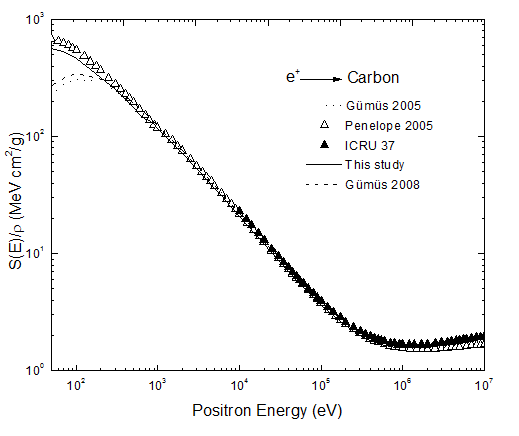
Figure 2 S(E)/ for incident positron energies, in carbon. —, present study; …, theoretical data from Gumus
12; and ----, from Gumus
29 model; ∆, results calculated by PENELOPE Program;
27 ▲, data from ICRU 37 report (1984).
Figure 3 shows the mSP for incident positrons from 50 eV to 10 MeV energy range in nitrogen. The results obtained from this study are compared with the PENELOPE program.26 and results for positrons by using Gümüş calculation methods.12,28 The calculated PSPs values obtained by using Eqs. (21, 22) are good agreement with PENELOPE program 26 results to within 3%.
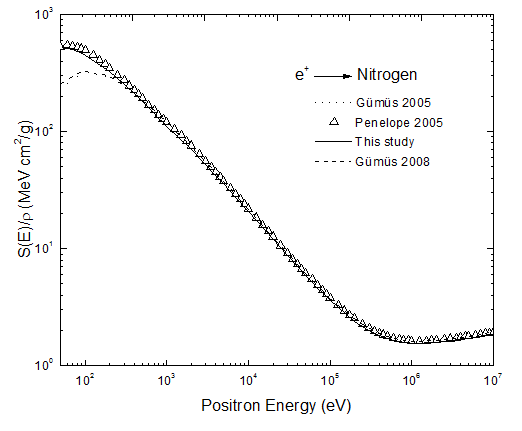
Figure 3 S(E)/ for incident positron energies, in nitrogen; —, present study; …, theoretical data from Gumus
12; and ----, from Gumus
29 model; ∆, results calculated by PENELOPE Program.
27
Figure 4 shows the mSP for incident positrons from 50 eV to 10 MeV energy range in oxygen. The results obtained from this study are compared with the PENELOPE program and results for positrons by using Gumus calculation methods.12,28 The calculated PSPs values obtained by using Eqs. (17,18) are good agreement with PENELOPE program 26 results to within 3%.
Figure 5 shows the mSP for incident positrons from 50 eV to 10 MeV energy range in phosphorus. The results obtained from this study are compared with the PENELOPE program 26 and results for positrons by using Gümüş calculation methods.8,29 The calculated PSPs values obtained by using Eqs. (17, 18) are good agreement with PENELOPE program22 results to within 2%. expect at energies below 300 eV.
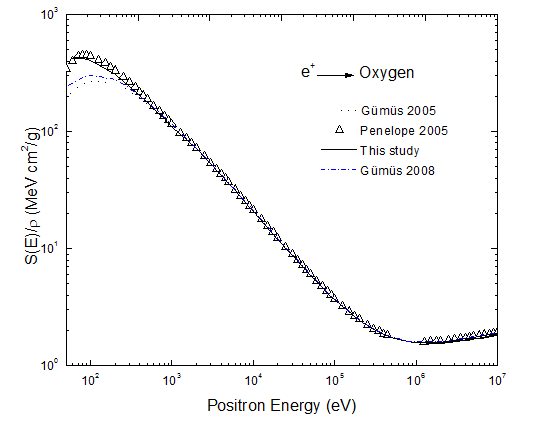
Figure 4 S(E)/ for incident positron energies, in oxygen. —, present study; ∆, results calculated by PENELOPE Program;
27 …. theoretical data of Gumus
12; and ---- theoretical data of Gumus.
29
Figure 6 shows the mSP for incident positrons from 50 eV to 10 MeV energy range in adenin. The results obtained from this study are compared with the PENELOPE program.26 The calculated PSPs values obtained by using Eqs. (17,18) are good agreement with PENELOPE program26 results to within 2%.

Figure 5 S(E)/ for incident positron energies, in phosphorus. —, present study; ∆, results calculated by PENELOPE Program;
27 …. theoretical data of Gumus8; and ---- theoretical data of Gumus.
29

Figure 6 S(E)/ for incident positron energies, in adenine. —, present study; ∆, results calculated by PENELOPE Program.
27
Figure 7 shows the mSP for incident positrons from 50 eV to 10 MeV energy range in cytosine. The results obtained from this study are compared with the PENELOPE program.26 The calculated PSPs values obtained by using Eqs. (17,18) are good agreement with PENELOPE program results to within 3%.
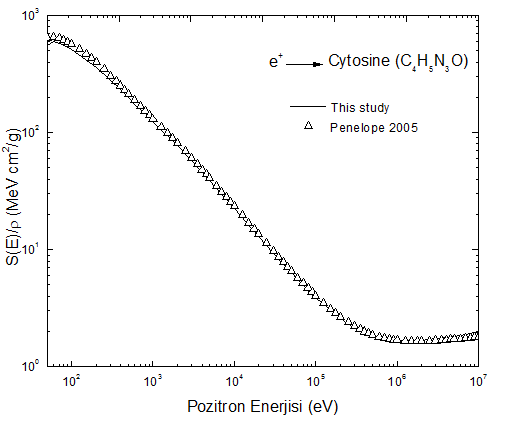
Figure 7 S(E)/ for incident positron energies, in cytosine. —, present study; and ∆, PENELOPE Program results.
Figure 8 shows the mSP for incident positrons from 50 eV to 10 MeV energy range in guanine. The results obtained from this study are compared with the PENELOPE program.26 The calculated PSPs values obtained by using Eqs. (17,18) are good agreement with PENELOPE program results to within 4%.

Figure 8 S(E)/ for incident positron energies, in guanine. —, present study; and ∆, PENELOPE Program
27 results.
Figure 9 shows the mSP for incident positrons from 50 eV to 10 MeV energy range in thymine. The results obtained from this study are compared with the PENELOPE program.22 The calculated PSPs values obtained by using Eqs. (17,18) are good agreement with PENELOPE program results to within 5%.

Figure 9 S(E)/ for incident positron energies, in thymine. —, present study; and ∆, PENELOPE Program
27 results.
Figure 10 shows the mSP for incident positrons from 50 eV to 10 MeV energy range in cytosine-guanine. The results obtained from this study are compared with the PENELOPE program.26 The calculated PSPs values obtained by using Eqs. (17,18) are good agreement with PENELOPE program results to within 5%.
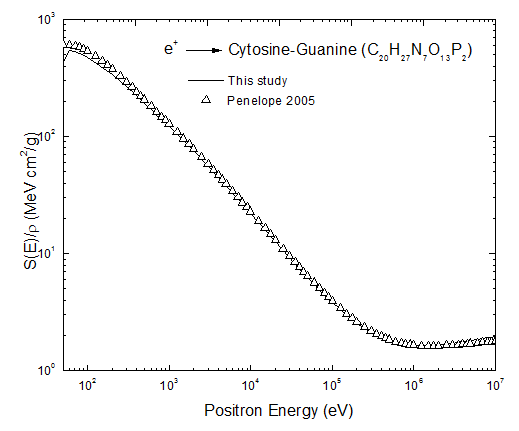
Figure 10 S(E)/ for incident positron energies, in cytosine-guanine. —, present study; and ∆, PENELOPE Program
27 results.
Figure 11 shows the mSP for incident positrons from 50 eV to 10 MeV energy range in thymine-adenine. The results obtained from this study are compared with the PENELOPE program .26 The calculated PSPs values obtained by using Eqs. (17,18) are good agreement with PENELOPE program results to within 5%.
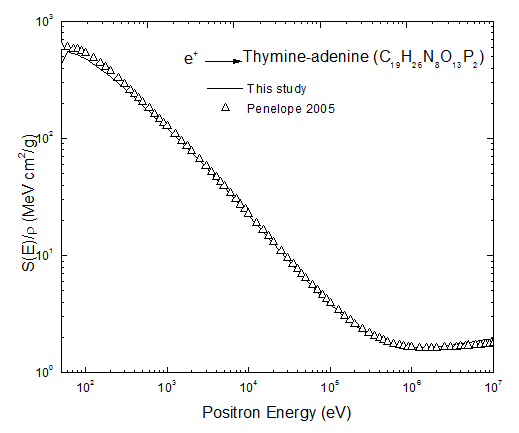
Figure 11 S(E)/ for incident positron energies, in thymine-adenine. —, present study; and ∆, PENELOPE Program
27 results.
Figure 12 shows the mSP values for incident positrons from 50 eV to 10 MeV energy range in liquid water. The results obtained in this study are in good agreement with the recommendations of ICRU 37 (1984) for the stopping power of liquid water. The results obtained from this study are compared with the PENELOPE program 26 and results for positrons by using Gümüş calculation methods.12,28 The calculated PSPs values obtained by using Eqs. (17,18) are good agreement with PENELOPE program results to within 3% above 300 eV energies. The mass stopping powers obtained by using the formalism described in this paper are in good agreement to within data of predictions of Pimblott30 above 500 eV energies,

Figure 12 S(E)/ for incident positron energies, in liquid water. —, present study; and ∆, PENELOPE Program
23 results. …. theoretical data of Gumus12; ---- theoretical data of Gumus
29; results of Pimblott
30 and ▲, results of ICRU 37 report.
2








